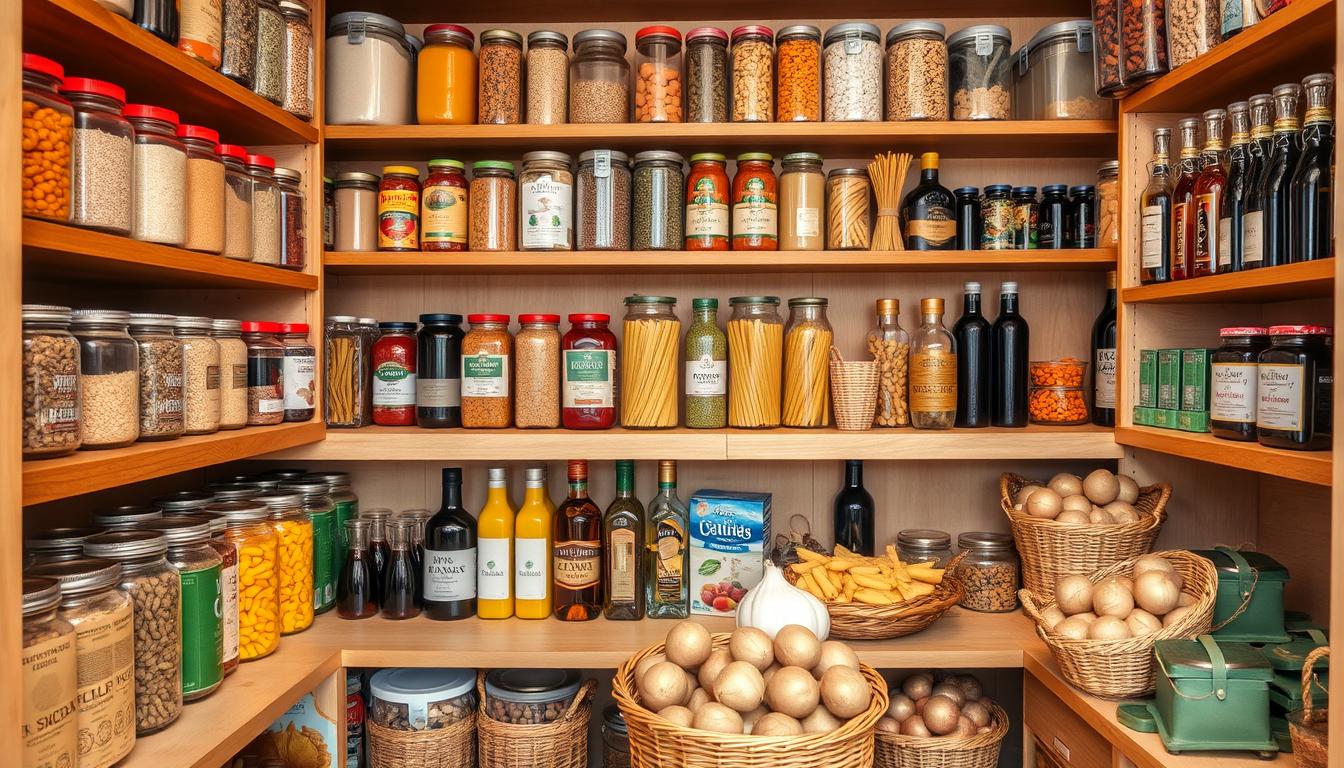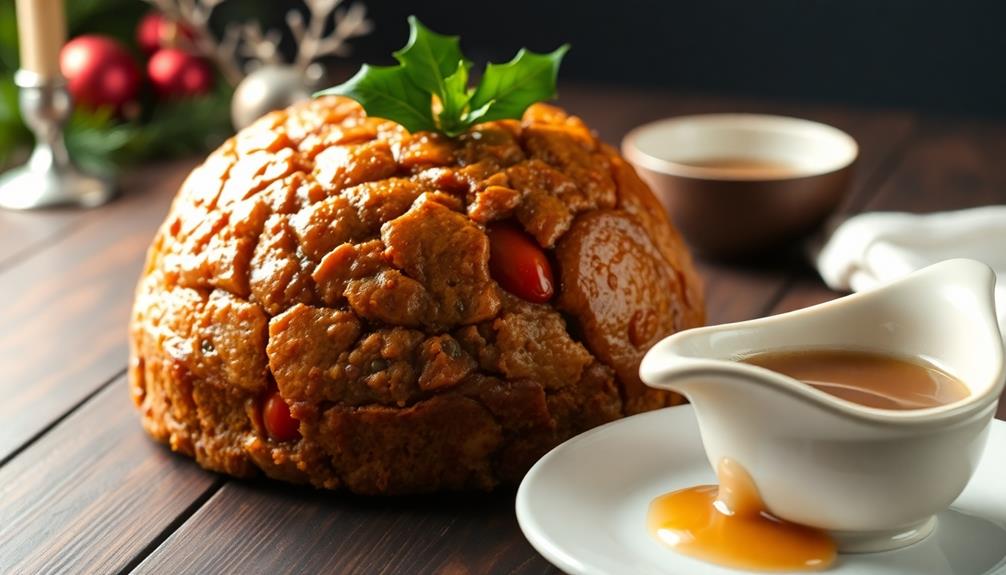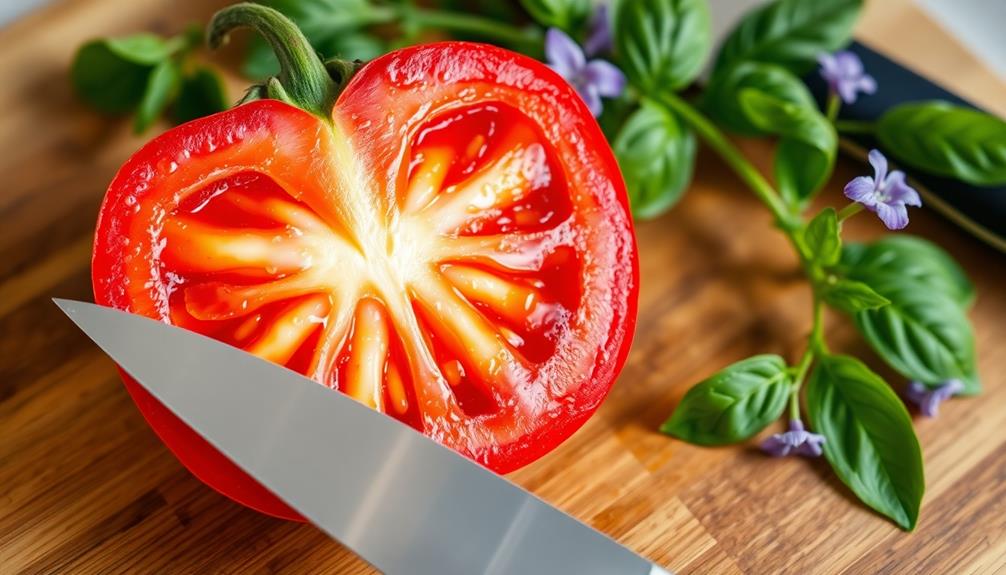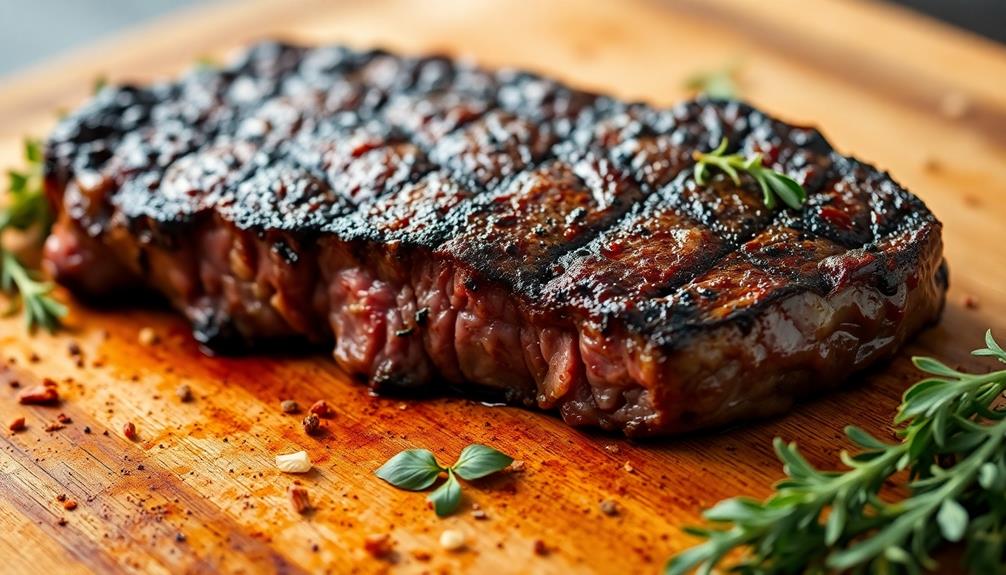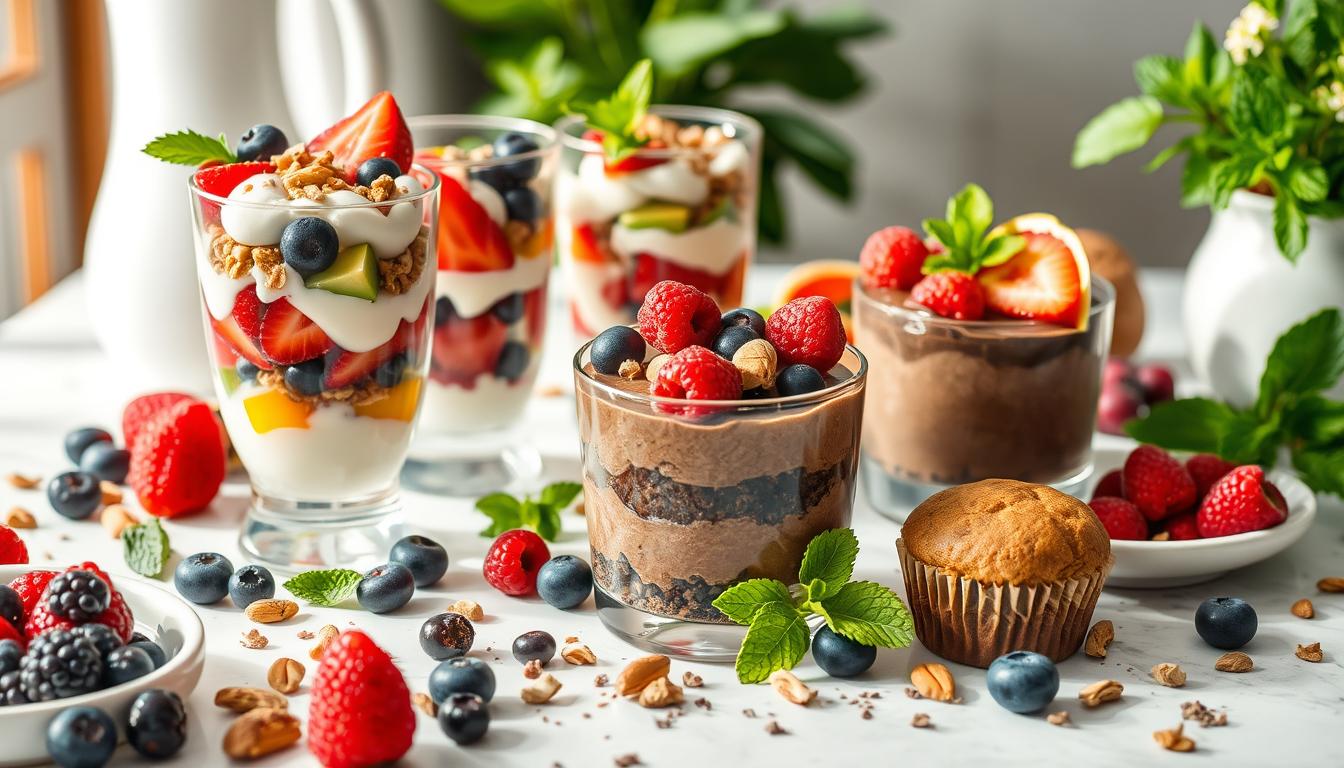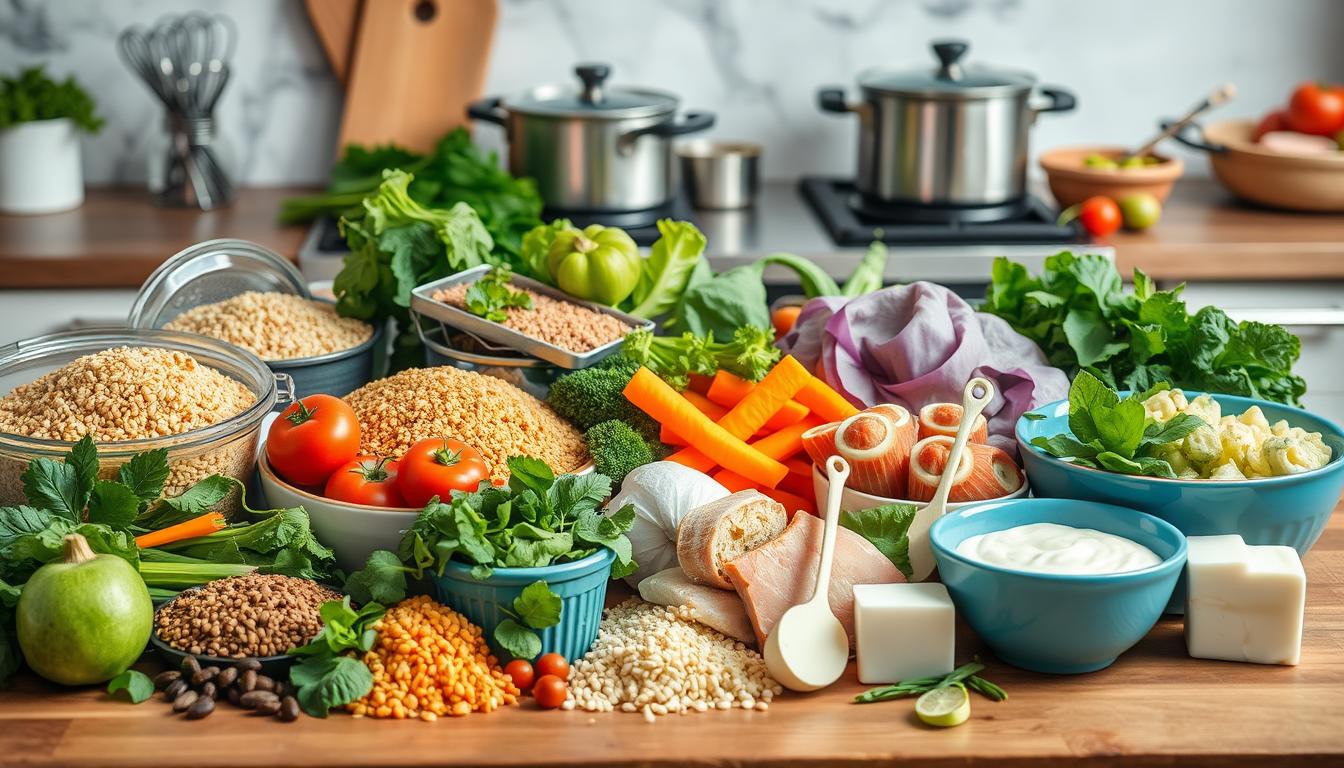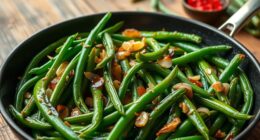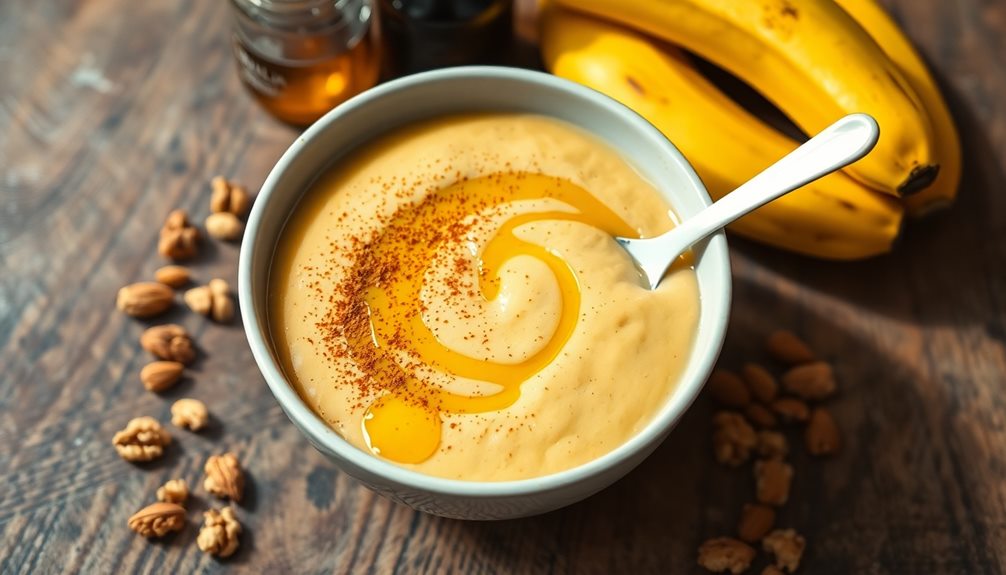As you step into your kitchen, the scent of sizzling garlic and the comforting sight of spices lined up like faithful companions remind you of countless meals prepared with love. Your pantry is more than just a storage space; it’s the backbone of your culinary adventures. Whether it’s a last-minute dinner or a weekend baking session, having the right pantry essentials at your fingertips can transform a simple dish into a memorable feast. The joy of creating new recipes, experimenting with flavors, and savoring every bite starts here. By stocking up on kitchen staples, you ensure that your cooking journey is filled with inspiration and ease, leading to delicious meals that nourish the body and soul.
Key Takeaways
- A well-stocked pantry enhances culinary creativity and efficiency.
- Organizing your pantry periodically can save time and money.
- Stocking versatile ingredients allows for quick meal preparations.
- Maintain a list of your pantry essentials for effective meal planning.
- Invest in high-quality, heart-healthy cooking oils and spices.
- Diversify your pantry with healthy snacks and plant-based proteins.
Understanding Pantry Essentials and Their Importance
A well-stocked pantry serves as the backbone of your kitchen, ensuring you have the necessary ingredients to whip up a variety of meals without frequent trips to the grocery store. Having pantry essentials on hand not only enhances the convenience of meal preparation but also encourages creativity in your cooking endeavors. Imagine the ease of crafting a delicious dinner after a long day, knowing that your pantry is filled with all the ingredients you enjoy. The benefits of a stocked pantry extend beyond mere convenience; it can significantly reduce food waste, allowing you to utilize what you have effectively.
Benefits of a Well-Stocked Pantry
Understanding the benefits of a stocked pantry can transform your cooking experience. Here are some significant advantages:
- Meal Planning Made Easy: A stocked pantry allows you to plan meals efficiently, using ingredients you already have.
- Encourages Creativity: With a variety of ingredients at your fingertips, experimenting with new recipes becomes more feasible.
- Reduces Food Waste: When ingredients are accessible, you are less likely to let items spoil in the fridge.
- Budget-Friendly: Buying pantry essentials in bulk often means lower costs and less impulse purchasing.
How a Stocked Pantry Saves Time and Money
Consider how a well-organized pantry helps you save time and money:
- Bulk Buying: Purchasing pantry staples in larger quantities often comes at a discount.
- Meal Efficiency: You can prepare meals quickly, especially on busy days, without needing to shop last minute.
- Reduced Spoilage: A well-maintained pantry not only keeps food fresher longer but also helps you track expiration dates effectively.
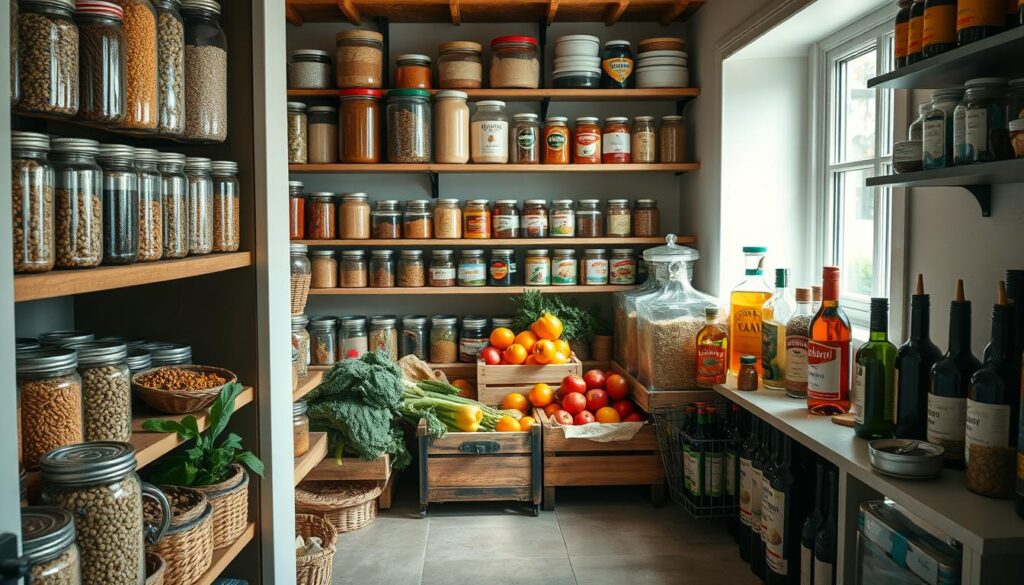
| Pantry Item | Shelf Life (in months) | Storage Recommendations |
|---|---|---|
| Dried Pasta | 12 | Keep in a cool, dry place |
| Rice & Dried Beans | 12 | Store in airtight containers |
| Vegetable Oils | 6 | Original bottles in cool, dark places |
| Spices | 12 | Store in airtight containers |
| Nuts (Refrigerated) | 6 | Refrigerate or freeze |
Key Pantry Staples You Should Always Have
Maintaining a well-stocked pantry is essential for creating delicious meals quickly and efficiently. Knowing which essential ingredients and must-have pantry items will enable you to whip up a variety of dishes with minimal effort. Below are some key pantry staples that you should include for seamless everyday cooking.
Essential Ingredients for Everyday Cooking
Dry goods are often the backbone of any pantry. They are generally affordable and offer versatility in numerous recipes. Here are some essential ingredients that deserve a prime spot on your shelves:
- Flour
- Sugar
- Oats
- Rice
- Cornmeal
- Baking powder
- Baking soda
- Cornstarch
- Dry beans
- Lentils
- Pasta
These items not only have a long shelf life but can be used in various ways—from baking to soups. Keeping these essential ingredients handy ensures you can always prepare satisfying meals.
Must-Have Pantry Items for Quick Meals
In busy households, having must-have pantry items can drastically reduce meal prep time. Here are some optimal choices:
- Peanut butter
- Jarred sauces
- Canned tomatoes
- Canned beans
- Pasta sauces
- Coconut milk
These ingredients are especially valuable when time is of the essence. You can create quick meals by combining pre-cooked grains, instant noodles, or a variety of frozen vegetables. Keeping these items on hand allows you to enjoy home-cooked meals even after long days, offering both convenience and nutrition.
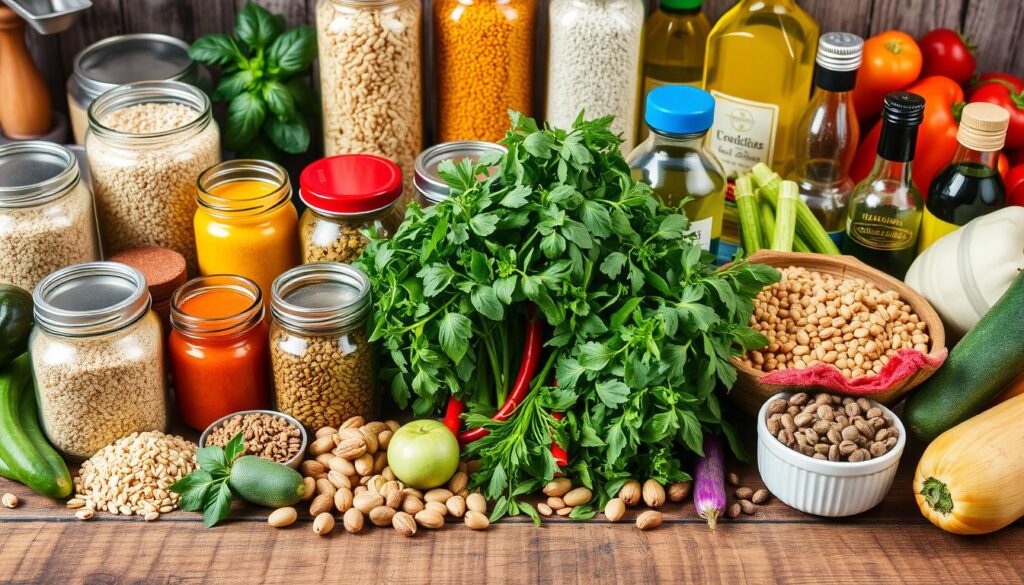
| Type of Pantry Item | Examples | Shelf Life |
|---|---|---|
| Dry Goods | Flour, Rice, Pasta | 1-2 years |
| Canned Goods | Tomatoes, Beans, Coconut Milk | 2-5 years |
| Frozen Items | Spinach, Blueberries | 6 months – 1 year |
| Herbs and Spices | Basil, Oregano | 2-3 years |
| Refrigerated Items | Milk, Eggs, Butter | 1-3 weeks |
This table highlights the various types of pantry staples and their longevity, ensuring you’re well-informed as you build your pantry arsenal. Knowing how to stock up efficiently saves you both time and money while enhancing your cooking experience.
Top Herbs and Spices to Elevate Your Cooking
Incorporating the right herbs and spices into your dishes can significantly enhance flavor and elevate your cooking game. Having a selection of essential herbs and spices is a fundamental part of your cooking essentials. Let’s explore some vital herbs and spices that can transform your meals.
Essential Herbs for Flavorful Dishes
Herbs like basil, thyme, and oregano serve as the backbone of numerous recipes. Dried herbs offer a longer shelf life, making them a practical choice for enhancing the flavor of your dishes at any time. Here are some essential herbs to consider stocking in your pantry:
- Basil – Perfect for Mediterranean dishes, pastas, and salads.
- Thyme – Versatile with citrus, mint, and woody notes.
- Oregano – A staple in Italian cuisine and pizza flavoring.
- Rosemary – Great for roasted meats and vegetables.
- Mint – Adds freshness to salads and drinks.
Common Spices and Their Uses
In addition to herbs, spices like cumin, paprika, and black pepper are essential for bringing depth and complexity to your cooking. Freshness and quality are key when choosing your spices, as they significantly impact flavor intensity. Consider the following common spices that should be part of your pantry essentials:
- Black Pepper – Known as the “king of spices” for its piney, citrusy aroma.
- Cayenne Pepper – Offers heat and may aid digestion.
- Cinnamon – Adds warmth and may help regulate blood sugar.
- Ginger – Excellent for reducing inflammation and enhancing taste.
- Nutmeg – A comforting spice, useful in both sweet and savory dishes.
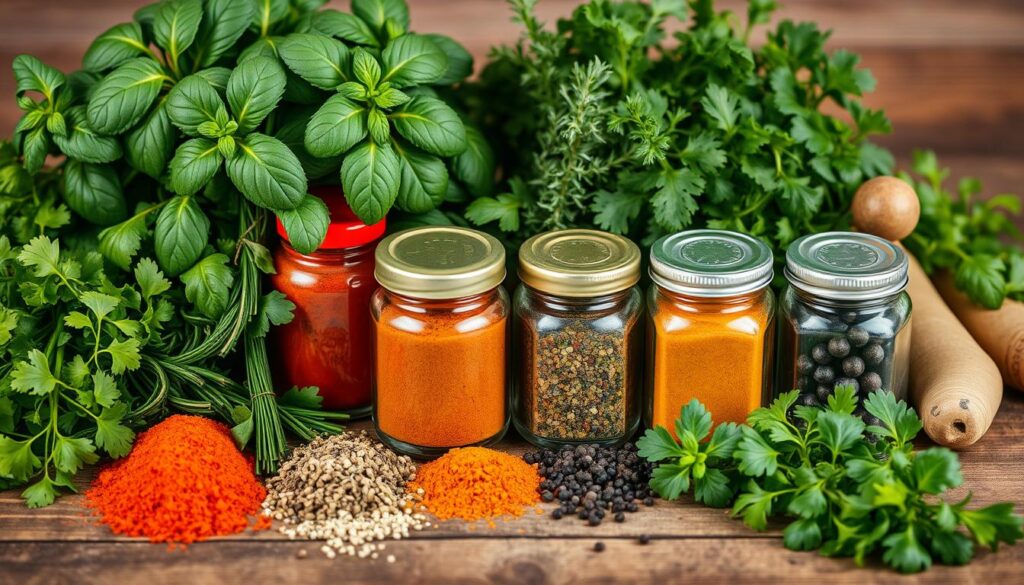
By stocking these essential herbs and spices, you will be well-equipped to create a wide variety of flavorful dishes in your kitchen. Embrace these pantry staples to unleash your culinary creativity and delight your taste buds.
Cooking Basics: Grains and Pasta
Understanding the role of various grains and pasta forms the foundation of cooking basics for any kitchen. Mastering the use of different varieties of rice and pasta not only enhances your culinary repertoire but also facilitates effortless meal preparation.
Varieties of Rice and Their Culinary Uses
A well-stocked pantry should include an array of rice types, each suitable for different dishes. Common options are:
- Basmati: Ideal for Indian and Middle Eastern dishes, it is fragrant and long-grained.
- Brown rice: A nutritious choice, offering a nutty flavor and chewy texture.
- Arborio: Essential for creamy risottos, it releases starch during cooking, creating a velvety consistency.
- Jasmine: Perfect for Thai recipes, its floral aroma pairs well with coconut milk.
- Long-grain white rice: Versatile for stir-fries and casseroles.
Embracing these varieties of rice allows for creative flexibility in cooking, adapting to diverse cuisines and preferences while ensuring that you meet specific cooking requirements.
The Role of Pasta in a Versatile Pantry
Pasta serves as a versatile staple that brings convenience and variety to your meals. Some common options include:
- Spaghetti: A classic pairing with tomato sauce.
- Penne: Works excellently in baked dishes.
- Fusilli: Perfect for holding onto sauces with its spiral shape.
- Fettucine: Best known for its partnership with creamy sauces.
- Macaroni: A go-to for comfort food like macaroni and cheese.
When you stock different pasta shapes, you gain the ability to whip up satisfying and diverse meals in no time. The ease of preparation aligns well with busy schedules, allowing families to enjoy homemade meals effortlessly.
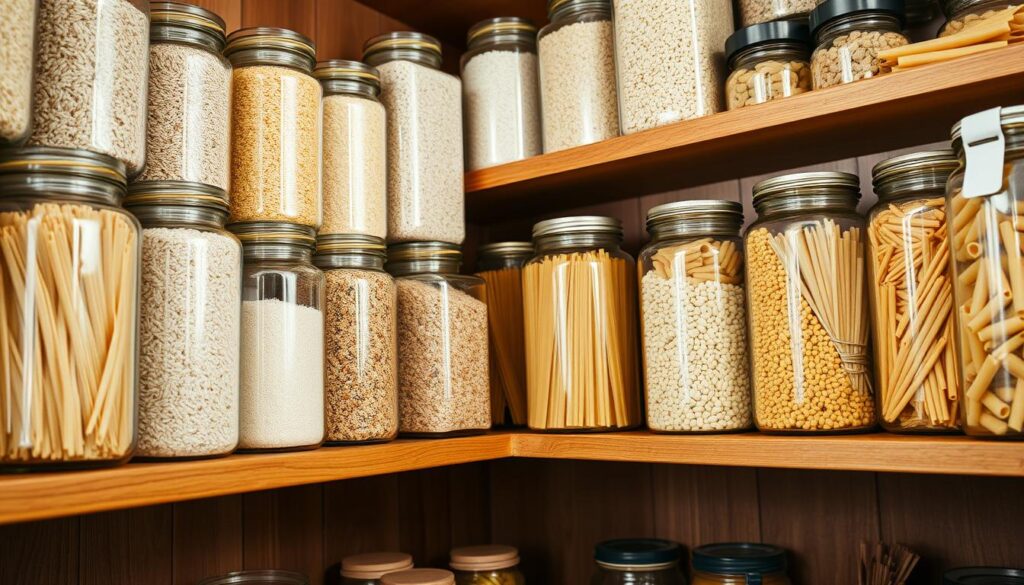
Canned and Jarred Goods: Convenience at Its Best
Canned and jarred goods play a crucial role in your pantry, making them essential convenience foods. With their long shelf life and versatility, you can quickly whip up satisfying meals using these staples. Here’s a closer look at some of the best canned vegetables and delicious canned meats and fish you should consider adding to your collection.
Best Canned Vegetables for Easy Meals
Canned vegetables are not only convenient but pack in essential nutrients, making meal prep easier. Here are some top choices:
- Canned Tomatoes: Perfect for dishes like Easy Chicken Tortilla Soup and Tikka Masala Soup, canned tomatoes are an undeniable pantry staple.
- Canned Beans: Varieties such as kidney, black, white, and garbanzo beans offer a protein boost to soups, stews, and salads.
- Coconut Milk: This creamy, plant-based option enhances both savory and sweet dishes, making it a versatile ingredient.
- Jarred Pasta Sauce: A fast solution for a busy night, jarred pasta sauce pairs beautifully with your choice of pasta.
- Stocks: Vegetable, chicken, and beef stocks enrich the flavor of many recipes, serving as foundational elements in soups and sauces.
- Canned Chilies: Smoky and spicy, canned chilies in adobo sauce elevate recipes like Turkey Pumpkin Chili.
Delicious Canned Meats and Fish Options
Canned meats and fish offer an array of options that enhance meal convenience without sacrificing nutrition.
- Tuna: A classic choice rich in omega-3 fatty acids, great for salads or sandwiches.
- Canned Chicken: An easy way to add protein to recipes, ideal for casseroles and wraps.
- Canned Beans: Not just for vegetables, these items serve as great protein sources while being versatile for a variety of dishes.
These pantry essentials are your gateway to creating delicious, quick meals while enhancing your cooking experience. Keep your pantry stocked, and you’ll always have the means to prepare satisfying dishes in no time!
| Item | Pack Size | Price on Amazon |
|---|---|---|
| Del Monte No Salt Added Corn | Pack of 24 | $58 |
| Gefen Red Beets | Pack of 3 | $14 |
| Dole Diced Peaches | Pack of 24 | $15 (13% off) |
| Pearls Large Pitted Black Olives | Pack of 6 | $14 |
| Thai Kitchen Unsweetened Lite Coconut Milk | Pack of 6 | $18 |
| Ortega Fire Roasted Diced Green Chiles | Pack of 12 | $16 (16% off) |
| Hatch Whole Green Chiles | – | $28 |
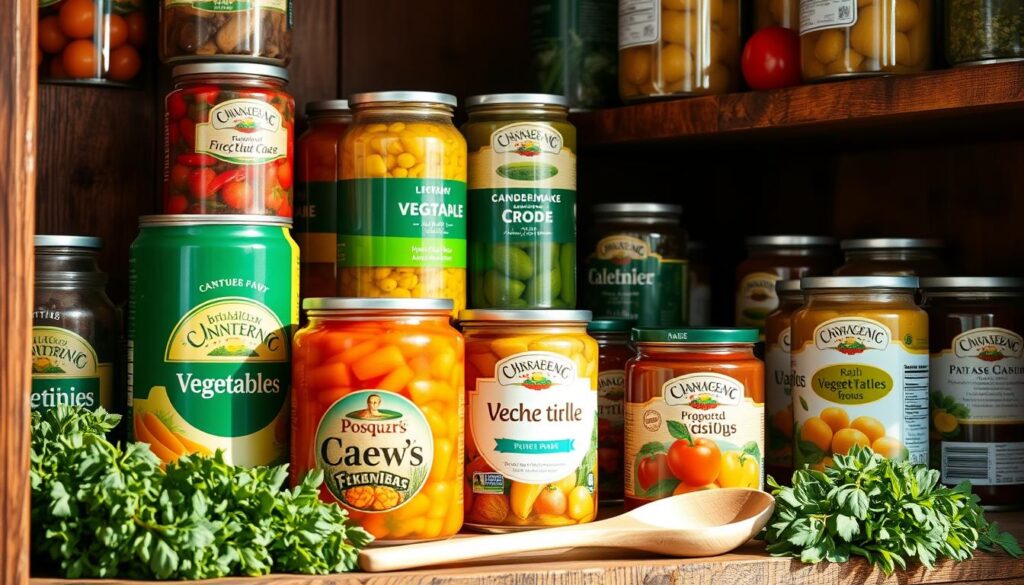
Baking Essentials to Keep on Hand
When it comes to creating delicious baked goods, having the right baking essentials in your pantry is crucial. A solid collection of must-have baking ingredients allows you to whip up everything from everyday cookies to elaborate cakes. This section focuses on the foundational items you need to explore your baking potential.
Flours and Sugars: The Building Blocks of Baking
Flour serves as the base for most baking recipes, and all-purpose flour accounts for approximately 80% of these recipes. It is incredibly versatile, ideal for cookies, cakes, and various bread types. Other notable flours include:
- Self-rising flour – Less common than all-purpose flour, used mainly in specific recipes.
- Bread flour – Contains higher protein content, perfect for chewy yeast breads.
- Cake flour – Lower protein levels contribute to lighter, tender cakes.
- Whole wheat flour – Delivers denser and more flavorful baked goods.
- Almond flour – Great for gluten-free baking.
Sugars, specifically granulated and light brown sugar, are essential in keeping baked goods moist and tender. Granulated sugar is a staple, while light brown sugar adds a hint of caramel flavor. Powdered sugar, ideal for frosting and dusting, rounds out your sugar collection.
Other Must-Have Baking Ingredients and Supplies
Beyond flour and sugar, several other ingredients enhance your baking experience. Eggs make up the foundation of most recipes, providing structure and stability. Unsalted butter offers better salt control, while baking powder and baking soda act as crucial leavening agents.
Do not overlook the importance of flavoring. Pure vanilla extract is a must for enhancing a variety of baked goods. Keeping baking chocolate and unsweetened cocoa powder on hand allows for experimenting with chocolate-rich recipes. Cornstarch can serve as a thickener in fillings and custards, and recommended spices like cinnamon and nutmeg add warmth and depth.
Your pantry should also include essentials like:
- Honey – A natural sugar alternative for various recipes.
- Dairy products – Milk, buttermilk, and cream cheese are vital for achieving the right texture.
- Vegetable oil – Another essential fat that promotes moistness in baked goods.
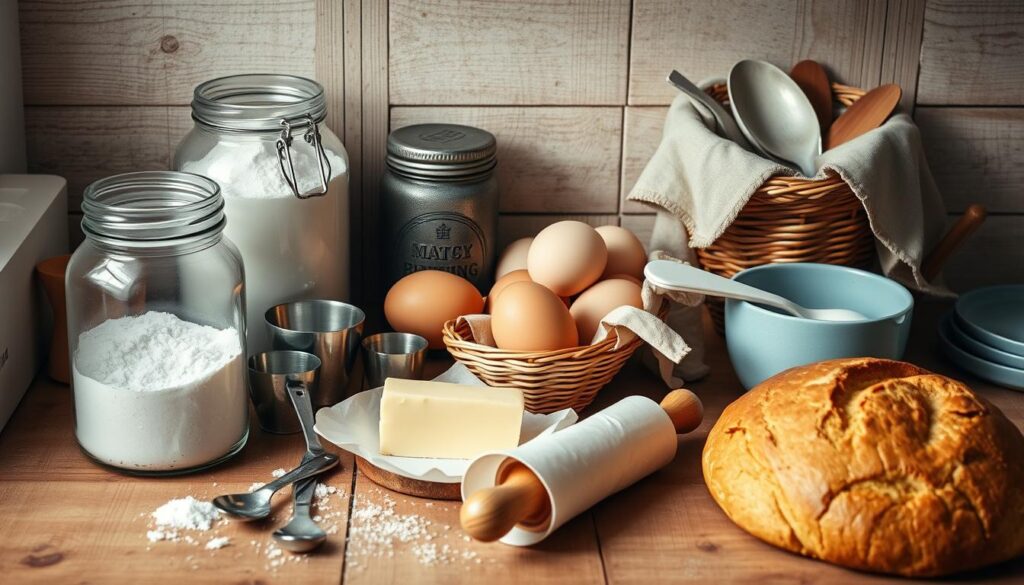
Healthy Pantry Options: Snacks and Nuts
When it comes to maintaining a balanced diet, stocking up on healthy pantry options is essential. Snacks play a crucial role in your daily nutrition, especially when those snacks are rich in nutrients. Consider integrating dried fruits, nuts, and nut butters into your pantry. These items not only provide quick energy but also enhance your meals in delightful ways.
The Benefits of Dried Fruits and Nuts
Dried fruits and nuts are fantastic pantry snacks that offer numerous health benefits. Nuts and seeds brim with healthy fats and fiber, making them excellent choices for satisfying hunger. Dried fruits provide natural sweetness, delivering essential vitamins and minerals.
- Dried fruits and nuts are nutrient-dense, meaning low calories packed with vitamins.
- These snacks have a long shelf life, making them practical for any pantry.
- Both ingredients add texture and flavor to dishes, from salads to baked goods.
Nut Butters: A Versatile Kitchen Staple
Nut butters, such as those made from almonds or peanuts, are must-have items in your pantry essentials. These spreads offer a wealth of healthy options for meals and snacks.
- Nut butters are rich in healthy monounsaturated fats and protein.
- They can be used in smoothies, on toast, or as a dip for fruits and vegetables.
- Having a variety of nut butters fosters culinary creativity and encourages nutritious eating habits.
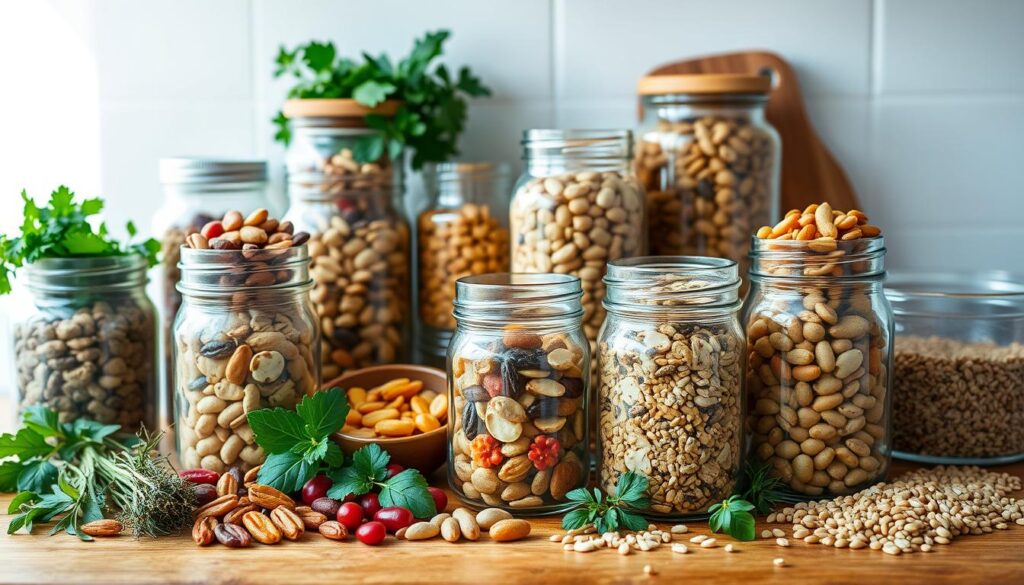
In total, you have access to 33 healthy pantry snacks that balance macronutrients, ensuring you get the right mix of proteins, carbohydrates, and fats. Planning ahead with a variety of satisfying snacks can keep your diet enjoyable and nutritious. Mindful eating practices can further enhance the enjoyment of these snacks, allowing you to indulge without guilt.
| Snack Type | Key Benefits |
|---|---|
| Dried Fruits | High in vitamins, natural sweetness |
| Nuts | Rich in healthy fats, fiber |
| Nut Butters | Good source of protein, versatile in recipes |
Oils, Vinegars, and Cooking Liquids: The Flavor Foundations
When it comes to enhancing your culinary creations, a variety of oils and vinegars serves as essential flavor foundations in your kitchen. With proper selection, you can unlock a world of taste suitable for various cooking styles and preferences. Ensuring you have at least 10 different types of these pantry staples will prepare you for countless recipes and cooking adventures.
Choosing the Right Oils for Cooking and Dressing
Cooking oils play a pivotal role in both flavor and technique. A well-rounded selection often includes:
- Olive oil – A favorite for its rich flavor and versatility; consider keeping three types on hand for different uses.
- Vegetable oil – Ideal for frying and sautéing, known for its high smoke point.
- Canola oil – A neutral oil that works well in various dishes.
- Sesame oil – Add this specialty oil for Asian recipes, but store it in the fridge to maintain freshness.
Using the right oil for the dish not only enhances the flavor but can also contribute to health benefits. Whether you’re roasting vegetables, dressing salads, or frying fish, selecting the appropriate cooking oil is vital.
Types of Vinegars and Their Culinary Uses
Vinegars offer unique acidity and depth of flavor to your dishes. Keeping a selection on hand allows you to balance flavors effectively. Some key varieties include:
- Balsamic vinegar – Perfect for dressings and marinades.
- Apple cider vinegar – Known for its tangy flavor, great in salads.
- Red wine vinegar – A classic in Mediterranean cooking.
- Rice vinegar – Especially useful in Asian cuisine for its lighter and sweeter profile.
Incorporating these vinegars into your pantry can help you create delicious marinades, dressings, and sauces. Their diverse culinary uses elevate the flavor profile of everyday dishes. Being equipped with these liquid essentials ensures you’re always ready to prepare well-rounded meals.
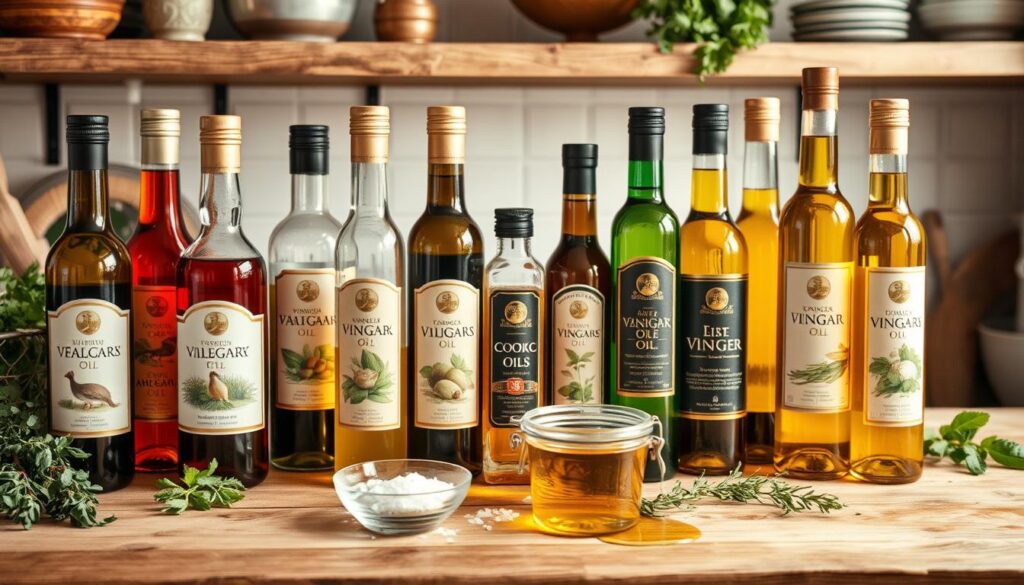
| Type | Use | Flavor Profile |
|---|---|---|
| Olive Oil | Cooking & Dressings | Fruity & Nutty |
| Vegetable Oil | Frying & Baking | Neutral |
| Canola Oil | General Cooking | Mild |
| Sesame Oil | Specialty Dishes | Nutty |
| Balsamic Vinegar | Dressings & Marinades | Sweet & Tangy |
| Apple Cider Vinegar | Salads & Cooking | Fruity & Tart |
| Red Wine Vinegar | Mediterranean Dishes | Tangy & Robust |
| Rice Vinegar | Asian Cuisine | Light & Sweet |
Pantry Essentials: A Comprehensive Stock-Up List
Creating a well-rounded pantry means including a diverse selection of basic pantry items that cater to various culinary needs and preferences. A well-thought-out pantry stock-up list should cover everything from canned goods to baking essentials, ensuring you have the ingredients necessary for any meal. Below is a list of items to consider for stocking your pantry effectively.
Items for a Well-Rounded Pantry
- Canned goods: tomatoes, beans, and tuna
- Prepared grains: rice, quinoa, and pasta
- Baking essentials: flour, sugar, and baking soda
- Cooking oils: olive oil, vegetable oil, and peanut oil
- Spices and herbs: oregano, cumin, and cinnamon
- Condiments: ketchup, mustard, and soy sauce
- Dairy staples: milk, cheese, and butter
- Frozen items: vegetables like peas and corn, and proteins such as chicken and shrimp
- Snacks: popcorn, nuts, and crackers
- Fresh items: onions, potatoes, and garlic
Tips for Organizing Your Pantry for Efficiency
Efficient organization of your pantry helps streamline your cooking process. Here are some tips for achieving a well-structured pantry:
- Group similar items together: Organize by category such as grains, canned goods, baking supplies, and snacks.
- Use clear containers for dry goods: This not only looks tidy but allows you to easily see what you have.
- Label everything: Use labels to maintain clarity on what’s inside each container.
- Rotate older products to the front: This minimizes waste by ensuring you use items before they expire.
- Keep frequently used items at eye level: Ensure easy access to the essentials that you reach for most often.
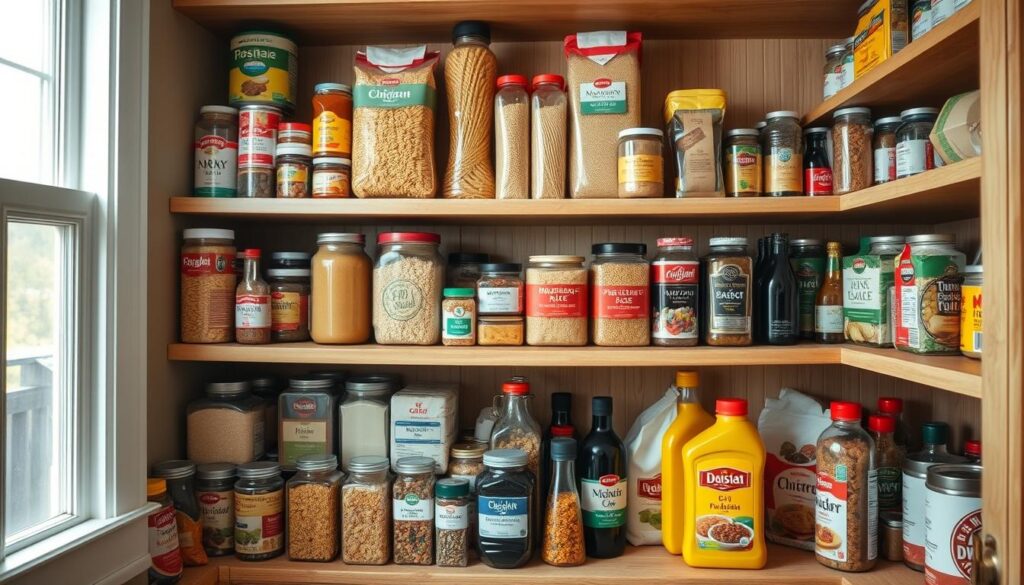
With this comprehensive pantry stock-up list, you can create a space filled with basic pantry items that will serve all your culinary needs. A well-stocked pantry ensures you’re prepared to whip up delicious meals with ease.
Conclusion
Building a well-stocked pantry is the cornerstone of enjoyable cooking and easy meal preparation. With the right pantry essentials in hand, you’ll find that whipping up delicious and nutritious meals becomes a seamless part of your daily routine. As you gather your stock-up list, consider incorporating a variety of oils, grains, canned goods, and baking supplies to ensure versatility in your cooking.
Organizing your pantry effectively enhances your culinary experience. Invest in air-tight storage containers and label them for easy access to your favorite items. Utilize baskets for grouping similar products and try using small glass containers for storing herbs and spices. With these organizational items, you can quickly locate what you need, even on those busy weeknights when you’re not sure what to cook. Consider installing wall-mounted racks or shelves for additional kitchen storage solutions. These can help free up counter and cabinet space, allowing for a more streamlined and efficient cooking process. By incorporating these kitchen storage solutions, you can create a well-organized pantry that not only makes meal prep easier but also adds a touch of aesthetic appeal to your kitchen.
As you embark on filling your pantry, remember that it’s about creating a space that fosters creativity and allows for culinary experimentation. From essential produce like garlic and onions to a diverse selection of spices, the pantry essentials you choose will influence your cooking adventures. By refining your stock-up list and maintaining an organized pantry, you’ll be ready to tackle any meal that comes your way, whether it’s a quick dinner or an elaborate baking project!
